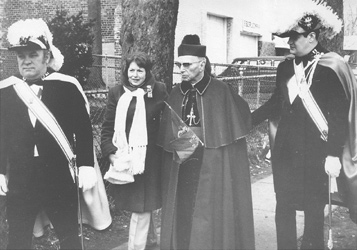Most Rev. Thomas A. Boland, S.T.D., LL.D.

Most Reverend Thomas A. Boland, S.T.D., LL.D., was installed as the Second Archbishop of Newark on January 14, 1953. Boland was educated at Seton Hall where he had been valedictorian of his class. He was a seminarian at the North American College in Rome where he was also ordained. He eventually came to chair both moral theology and canon law at the Seminary. In 1940 he was appointed Auxiliary Bishop in recognition for his hard work in multiple offices and capacities. He was elevated to Bishop of Paterson in 1947 where he stayed until the death of his mentor, Archbishop Walsh.
Archbishop Boland participated in the Vatican Council II in Rome which was in session from 1962 to 1965. He was elected by his peers to head the Bishops’ Study Committee, to which he was reelected each of his three years there. Additionally he was chosen to serve on the Catholic Mission Board of the United States, Chair of the Episcopal Committee and as liaison between women religious and the hierarchy of the United States. Upon returning to Newark the turmoil of the 1960’s was erupting.
The Newark community was torn with racial strife during the Civil Rights Movement. Archbishop Boland made it clear that he would not allow the rights of African Americans to be compromised. He urged compliance with the Bishops’ Letter on Social Justice (1958) which emphasized the Catholic obligation to ensure that all African Americans had all of the rights guaranteed under the U.S. Constitution. In 1967 the Newark Riots began but did not deter the clergy from their mission.
Boland dedicated the finished Cathedral of the Sacred Heart on October 19, 1954. He retired on April 2, 1974 and died on March 16, 1979. His remains rest with some of his predecessors in Sacred Heart Cathedral’s crypt.
Legendary Archbishop Boland served 21 years
By Msgr. Francis R. Seymour
Archivist of the Archdiocese of Newark
With the passing of the years, the number of us who remember Archbishop Thomas A. Boland is dwindling rapidly. That would not have bothered him because he never wanted to call attention to himself. However, he is too important to the history of our Archdiocese to be ignored.
March 16 was the 25th anniversary of his death. The world and the Church have changed enormously since then, but he faced a similar challenge when he was Archbishop of Newark from 1953 to 1974. For roughly the first half of those 21 years, he devoted much of his time to the expansion of this Archdiocese in terms of parishes, buildings and agencies.

One of the first projects to reach completion was the Cathedral of the Sacred Heart, a feat that was in the dreams of each of his predecessors.
This magnificent edifice was solemnly opened fifty years ago October 19, the same day Archbishop Boland received his pallium from the Apostolic Delegate to the United States, Archbishop (later Cardinal) Amleto G. Cicognani.
The latter half of his administration was marked by struggles that mirrored national concerns: the effects of the Second Vatican Council and the fight for civil rights. He attended all of the sessions of that historic gathering of the bishops of the world and had several leadership positions in the U.S. hierarchy while there.
He put the teachings of the Council into effect and mandated periods of instruction for the people to understand the many liturgical changes that took place in those years. One of the first of these actions was the establishment of the Senate of Priests (now known as the Presbyteral Council) and the Archdiocesan Pastoral Council.
The struggle to gain the natural rights of freedom for oppressed minorities raged throughout the nation in the late 1960’s. This same fight struck home dramatically during the Newark riots of 1967.
Archbishop Boland visited the riot-torn area and sought to solve one of the causes of the riots by establishing a housing program under the guidance of the Mount Carmel Guild (now known as Catholic Community Services).
Two years later, the civil rights issue focused on Archbishop Boland personally when 20 priests accused him of racism. They argued that leadership in racial matters was absent in the Archdiocese of Newark. He met with these priests and refuted the charges made against him one by one and declared that the things he was accused of were contrary to everything he had been attempting to do.
Although these charges had caused much bitterness on both sides, the priests and the archbishop eventually reached an agreement to address the concerns they raised, and a spokesman for the priests later said he would not now characterize the archbishop’s personal attitude as “racist.”
Archbishop Boland told me many years ago that all he ever wanted to be was a parish priest. He held that position for a couple of months in the summer of 1923 when he returned from Rome after his ordination to the priesthood.
Then, he said, “the Bishop (Most Rev. John J. O’Connor) assigned me to Seton Hall to teach and that was that.” However, he filled just about every other position in the structure of this Archdiocese.
He never looked for any office that came his way, but he put his heart and soul into every job he ever had.
Archbishop Boland died twenty-five years ago, but those of us who worked with him and knew him well can never forget the influence he had on our lives and on this Church of Newark. He was one of the gentlest men who ever lived.
His devotion to the Blessed Mother and the Holy Father was legendary. I do not recall a homily or talk he ever gave without referring to both of them.
In this age when heroes are “created” instantly by American popular culture and mass communications, I will always think of Archbishop Boland with the description given to St. Thomas More: “A man for all seasons!”
Reprinted form The Catholic Advocate.
